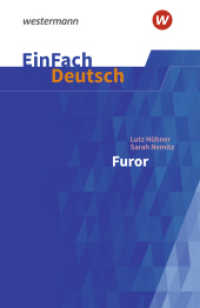- ホーム
- > 洋書
- > ドイツ書
- > Humanities, Arts & Music
- > Music
- > instrumental instruction
Description
(Short description)
Was ist beim Flötenspiel ein "guter" Ton? Was ist gemeint mit den berühmten "joli son" der Franzosen? Wir denken dabei an Kriterien wie "sauber" (d.h. arm an Nebengeräuschen), "farbig" (d.h. timbriert und weniger timbriert), "flexibel" (d.h. geschmeidige Dynamik). Solche und ähnliche Eigenschaften sind heute elektronisch perfekt herstellbar. Im Gegensatz dazu ist es mein Anliegen, den Flötenton nicht als ästhetischen Selbstzweck, sondern als lebendiges Ausdrucksmittel zu verstehen; ihn nicht in erster Linie als akustisches, sondern hauptsächlich als musikalisches Ereignis zu erleben.Die hier zusammengestellten Melodien sind der Opern- und Flötenliteratur entnommen und behandeln drei Themenkomplexe: 1. Gesanglichkeit im Piano, 2. flexible Dynamik und Wechsel der Tonfarbe, 3. Klangfülle und Intensität.Besetzung:Flöte
(Text)
The Singing Flute - die ideale Applikation des "Tone Developpement" von Marcel MoyseWas ist beim Flötenspiel ein "schöner" Ton? Sicher mehr als nur die Tonkriterien "sauber" (d.h. arm an Nebengeräuschen), "farbig" (mehr oder weniger timbriert), "flexibel" (geschmeidige Dynamik) oder ein möglichst großer Ton. Das Anliegen des bekannten Flötisten P.-L. Graf ist, den Ton nicht als ästhetischen Selbstzweck, nicht als akustisches Ereignis, sondern hauptsächlich als lebendiges Ausdrucksmittel und "musikalisches" Phänomen zu verstehen. Im vorliegenden Übungsheft (mit Klavierbegleitung) hat er Beispiele aus der Flöten- und Opernliteratur ausgewählt, um daran drei Themenkomplexe zu erarbeiten: 1. Gesanglichkeit im Piano, 2. flexible Dynamik und Wechsel der Tonfarbe, 3. Klangfülle und Intensität.Ein konzentriertes Fortbildungsprogramm für alle Flötisten, vom Studenten bis zum Profi.Schwierigkeitsgrad: 4
(Table of content)
Vorwort: "Akustischer" und "musikalischer" Ton - Einführung - dolce-cantabile-pinao - Flexibilität - sonore-forte
(Short description)
Just what is a "good" on the flute? What is really meant by the famous "joli son" of the French? When we try to define it, we come up with criteria such as "clean" (i.e. not breathy), "coloured" (i.e. with variations of timbre) and "flexible" (i.e. supple change of dynamics). All these qualities, and more, can these days be produced perfectly electronically. In contrast to this, it is our concern to understand the sound of flute not merely as its own aesthetic goal but also as a living means of expression: to experience it first and foremost as a musical occurence, not an acoustic phenomenon.The melodies collected here have been taken from the opera and flute repertoire. They deal with different categories of musical expression: 1. singing quality in a piano dynamic, 2. flexibility of dynamics and changing tone colour, 3. full sound and intensity.Besetzung:flute
(Text)
What is a good tone in flute playing? Surely it must be more than just clean (ie not producing many unwanted sounds), colourful (with adequate timbre), flexible (able to produce dynamic adjustments) or just a really big tone. The well-known Swiss flautist P.-L. Graf is concerned that the production of tone should not be seen as an aesthetic end in itself, but chiefly as a living means of expression and as a musical event. In this practice volume he has picked 3x7 examples from the flute and operatic repertoire in order to work through three sets of themes: 1.) cantabile playing at a piano dynamic, 2.) dynamic flexibility and variation of tone colour, 3.) fullness and intensity of sound. This offers concentrated training for all flautists, from student through to professional player.Instrumentation:flute








